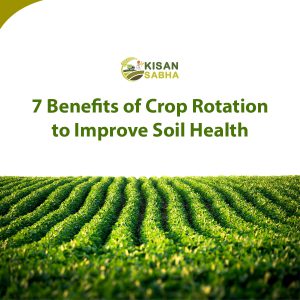One of the most important cereal crops in the world, maize, sometimes referred to as maize, is used in animal feed and a variety of industrial products in addition to being a staple food source. An abundant crop of maize depends on adequate fertilization. This in-depth tutorial will take you step-by-step through the complexities of Corn Fertilization, from identifying the nutrients the plant needs to choosing the best fertilizers and application techniques for maximum growth.
1: Comprehending the Nutritional Requirements of Corn
1.1. Nutrients, both Macro and Micro
Like all plants, maize needs a variety of vital nutrients to grow healthily. The main nutrients consist of:
- Firstly, Nitrogen (N) is required for the growth of leaves and stems.
- Secondly, Phosphorus (P): Encourages root growth and flowering.
- Finally, Potassium (K): Promotes plant health by aiding in disease resistance and stress tolerance.
Corn requires micronutrients such as iron, manganese, zinc, and copper in smaller amounts in addition to these macronutrients to ensure proper metabolic functions.
1.2. Nutrient Intake Throughout the Growth Stages
It is critical to understand when and how maize plants absorb nutrients. Corn Fertilization goes through several stages of development:
- At this stage, the plant primarily requires phosphorus.
- Nitrogen becomes critical for leaf and stem development during vegetative growth.
- Reproductive Growth: Nitrogen and potassium are both essential for flowering and grain development.
2: Soil Analysis and Testing
Before beginning a Corn Fertilization program, understanding your soil’s nutrient content is critical. Also, soil testing provides information about current nutrient levels and pH levels, allowing you to make educated fertilization decisions.
2.1. Soil Sample Collection
To collect accurate soil samples, follow these steps:
- First, collect samples at the appropriate soil depth (usually 6-8 inches) with a clean, non-corrosive tool.
- Next, collect multiple samples from different areas of your field or garden to account for potential variations.
- Finally, after thoroughly mixing the samples, send them to a reputable soil testing lab for analysis
2.2. Interpreting Soil Test Results
The soil test report will include nutrient levels and pH. Use this data to determine which nutrients require supplementation and at what rate. However, your local agricultural extension office can assist you in interpreting the results and making recommendations.
3: Choosing the Best Fertilizers
3.1. Types of Fertilizers
There are several types of fertilizers, but for maize, you’ll primarily be concerned with:
- Complete fertilizers:- contain all three primary macronutrients (N-P-K) in varying ratios. A common maize seed mixture is 10-10-10 or 20-20-20.
- Specialized Fertilizers:- Some fertilizers are designed to meet specific requirements. For maize, you could use nitrogen-rich urea or ammonium nitrate.
3.2. Organic vs. Synthetic Fertilizers
- Organic Fertilizers:- Organic fertilizers, derived from natural sources, slowly release nutrients and improve soil structure. Compost, manure, and bone meal are all examples.
- Synthetic Fertilizers:- Synthetic fertilizers provide nutrients in readily available forms but can cause nutrient imbalances if not applied correctly.
Also Read:- The latest Agricultural Technologies in 2024
4. Fertilization Methods and Timing
4.1. Fertilization Before Planting
Consider using a starter or base fertilizer before planting maize. There are several ways to accomplish Corn Fertilization.
Broadcasting: Using tillage equipment, spread the fertilizer evenly across the soil surface and incorporate it into the topsoil.
During seeding, apply a small amount of fertilizer to the planting furrow.
4.2. Dressing from the Side
During the vegetative growth stage, side-dressing is the application of fertilizer alongside the growing maize plants. This method enables precise application while reducing nutrient waste. Consider the following:
Liquid 2: Liquid nitrogen solutions can be injected into the soil near the plant’s base.
Dry granules can be applied between rows and then incorporated into the soil as a fertilizer.
Foliar feeding can be beneficial in certain situations, particularly when addressing nutrient deficiencies. This entails spraying a nutrient solution directly onto the maize leaves for rapid absorption. However, it should be used in conjunction with soil fertilization, not as a stand-alone method.
5: Fertilizer Application Rates
5.1. Determining Application Rates
- Several factors influence the appropriate application rate, including:
- Soil nutrient levels are determined by soil testing.
- The desired maize yield and nutrient requirements.
- The specific fertilizer type and nutrient content.
- Your soil test results and local agricultural recommendations will help you determine the exact application rates for your specific situation.
5.2. Corn Growth Stage Adjustment
- Corn’s nutrient requirements change as it grows. Prepare to adjust your fertilizer application accordingly:
- Increase the nitrogen ratio during vegetative growth.
- Therefore, as the plant enters the reproductive stage, concentrates on potassium and phosphorus.
6: Efficient Corn Fertilization Best Practises
6.1. Avoid Overfertilization
Excessive fertilizer use can harm the environment by causing nutrient runoff and wasting resources. However, stick to recommended rates and conduct soil tests regularly to fine-tune your approach.
6.2. Fertilizer Application
Proper placement is essential for nutrient uptake. Therefore, to avoid seed damage, place fertilizer near the root zone and avoid direct contact with seeds.
6.3. Fertilization at the Appropriate Time
Coordination of fertilizer application with maize growth stages is essential. When nutrients are applied when the plant requires them the most, efficiency gets maximized.
6.4. Regular Monitoring
Fertilization is an ongoing procedure. Monitor your crop’s health and growth regularly to identify any signs of nutrient deficiency or excess. Therefore, adapt your fertilization strategy as needed.
Also Read:- Analyzing the Advantages and Disadvantages of Mixed Farming
7: Common Corn Nutrient Deficiencies and Remedy
7.1. Nitrogen deficiency
- Signs include pale green or yellow leaves and stunted growth.
- Side-dress with nitrogen or use foliar nitrogen sprays as remedies. Before planting, check nitrogen application rates.
7.2. Phosphorus deficiency
- Stunted growth and purplish leaves are symptoms.
- Treatment: Use a phosphorus-rich fertilizer as a starter or during pre-planting.
7.3. Potassium Deficiency
- Yellowing or browning leaf edges and weak stalks are symptoms.
- Side-dress with potassium or use potassium-rich fertilizers when planting.
8: Environmental Concerns and Sustainability
8.1. Nutrient Runoff
To reduce environmental impact, avoid overfertilization and use recommended application rates. However, consider using slow-release or controlled-release fertilizers.
8.2. Sustainable Practises
Investigate sustainable farming practices such as crop rotation, cover cropping, and no-till farming to improve soil health and reduce the need for excessive fertilization.
Conclusion
Fertilizing maize for optimal growth is a dynamic process that necessitates a thorough understanding of the plant’s nutrient requirements, accurate soil testing, and appropriate fertilization methods. By following best practices, adjusting application rates to growth stages, and addressing nutrient deficiencies promptly, you can ensure a healthy, high-yielding maize crop while minimizing environmental impact. With careful planning and regular monitoring, you can reap the benefits of a successful maize harvest while maintaining sustainable agricultural practices.




